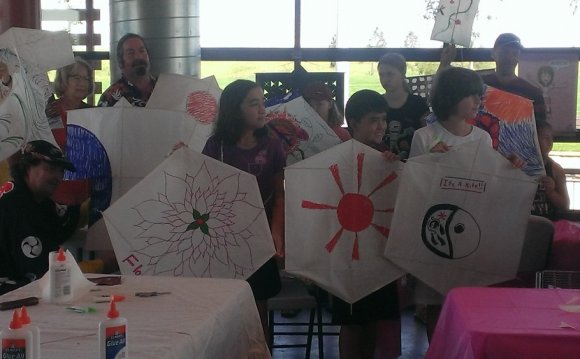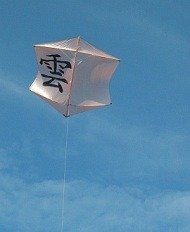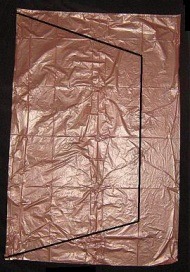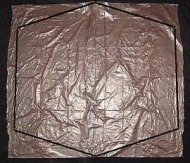

The MBK Dowel Rokkaku
This set of instructions on how to make a Rokkaku kite assumes you know absolutely nothing about kite making. You might already have some of the simple tools and materials required.
Anything you don't have is easily bought. If not exactly what I used, then at least something pretty similar!
The MBK Dowel Rokkaku is a fairly large tail-less design based on the traditional Japanese kite. However, it will still fit into nearly all road vehicles, ready to fly. Either just in front of the rear seat, or flat in the trunk (boot).
Like the other Japanese design in this series, the Sode, this kite is a light to moderate wind flier.
 Setting up on the flying field is just a matter of attaching the bow-line toggles to put some curvature into both the horizontal spars. Then the flying line is attached to the bridle. At this point you are ready to launch! The method of attachment is illustrated further down this page.
Setting up on the flying field is just a matter of attaching the bow-line toggles to put some curvature into both the horizontal spars. Then the flying line is attached to the bridle. At this point you are ready to launch! The method of attachment is illustrated further down this page.
Some like to make Dowel kites like this one in Tyvek.
OK, so these designs can fly tail-less - but adding extra stability or just creating a visual face-lift is still worth considering!
I have chosen to make '1 Dowel Length' equal to 120cm for every kite in the Dowel series. If you are in North America, 48" of 3/16" dowel is close enough to 120cm of 5mm dowel. This will result in a kite with similar flying characteristics to my original.
How To Make A Rokkaku Kite
Cutting the Sail
Now's the time to read up on the required for making a Dowel Rokkaku, if you haven't already. For this kite, you will also need some cheap thin shoe-laces.
 The template shown above represents one side of the kite sail. You will now transfer these measurements to the sail plastic as follows...
The template shown above represents one side of the kite sail. You will now transfer these measurements to the sail plastic as follows...
Note: In order to fit the length of an 80 liter garden bag, I made this design shorter than a traditional 4:5:6 Rok of the same wing-span. You see, I'm trying to standardize on a 1.2 meter wingspan for all the Dowel kites!
- Firstly, take a large bag that you want to use for the sail, and lay it flat on the floor.
- Mark dots on the plastic which correspond to the corners of the Template. There is no need to use a T-square, or an extra-long ruler since any small errors in position will be duplicated on the other side of the sail.
- Using the marking pen, rule lines between the dots, as in the photo. For lines longer than the ruler, just add a few extra dots using one of the dowel spars as a ruler! Then it's easy to connect the dots with a ruler. It's probably best not to rule the whole line with the dowel, since it bends easily.
- Flip the plastic bag over, and trace over all the black lines using your marker pen and ruler.
- Cut out a rectangular section of the bag containing the kite sail, open it out and lay it flat on the floor - you can now see the complete sail outline, as in the photo.
When doing the following, most of the width of the tape should be inside the kite's outline. Use a single length of tape for each line. Hold it out straight, touch it down to the plastic at one end, then at the other end, dab it down in the middle, then press down all along its length.
- Lay clear sticking tape along all the lines, letting it overlap at the corners.
- With scissors, cut along all the black lines. This will leave most of the width of the sticking tape inside the sail outline. See the photo.
- This VPK (Video Platform Kite) is, I suspect, a bit of a giggle now, to some who visit here or subscribe to the newsletter. I've been trotting out rather minimal amounts of information about the proje…
YOU MIGHT ALSO LIKE










